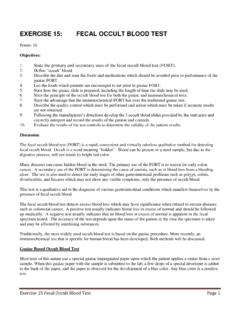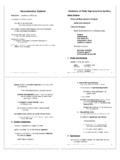Transcription of Horizontal and slant asymptotes of rational functions
1 asymptotes OF rational functions )()()(xDxNxfy where N(x) and D(x) are polynomials _____ By Joanna Gutt-Lehr, Pinnacle Learning Lab, last updated 1/2010 Horizontal asymptotes , y = b A Horizontal asymptote is a Horizontal line that is not part of a graph of a function but guides it for x-values far to the right and/or far to the left. The graph may cross it but eventually, for large enough or small enough values of x (approaching ), the graph would get closer and closer to the asymptote without touching it. A Horizontal asymptote is a special case of a slant asymptote. A recipe for finding a Horizontal asymptote of a rational function: Let deg N(x) = the degree of a numerator and deg D(x) = the degree of a denominator. deg N(x) = deg D(x) deg N(x) < deg D(x) deg N(x) > deg D(x) There is no Horizontal asymptote. Another way of finding a Horizontal asymptote of a rational function: Divide N(x) by D(x).
2 If the quotient is constant, then y = this constant is the equation of a Horizontal asymptote. Examples Ex. 1 Ex. 2 HA: because approaches 0 as x increases. HA : because approaches 0 as x increases. Ex. 3 = approaches as x increases (y = 3x 3 is a slant asymptote.) D(x) oft coefficien leading)N(x oft coefficien leadingyaxis- x theis which 0yASYMPTOTES OF rational functions )()()(xDxNxfy where N(x) and D(x) are polynomials _____ By Joanna Gutt-Lehr, Pinnacle Learning Lab, last updated 1/2010 slant (OBLIQUE) ASYMPTOTE, y = mx + b, m 0 A slant asymptote, just like a Horizontal asymptote, guides the graph of a function only when x is close to but it is a slanted line, neither vertical nor Horizontal . A rational function has a slant asymptote if the degree of a numerator polynomial is 1 more than the degree of the denominator polynomial. A recipe for finding a slant asymptote of a rational function: Divide the numerator N(x) by the denominator D(x).
3 Use long division of polynomials or, in case of D(x) being of the form: )c(x, you can use synthetic division. The equation of the asymptote is y = mx + b which is the quotient of the polynomial division (ignore remainder) _____ Examples 18216)(23xxxf deg N(x) = 3, deg D(x) = 2. Perform long division )()(xNxD: +1822x The slant asymptote s equation is: xy3 152)(2xxxxf deg N(x) = 2, deg D(x) = 1. Perform synthetic division: Zero of the denominator -1 2 1 -5 -2 1 _____ 2 -1 -4 this is the remainder The slant asymptote s equation is: 12xy remainder theis this154546316182332xxxxxxxyxy












